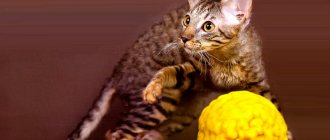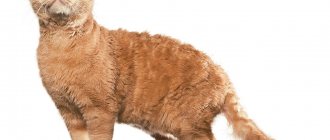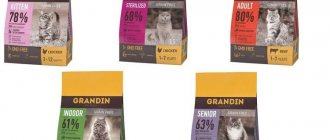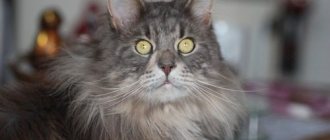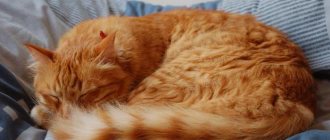Video
* We invite you to watch a video about the Cornish Rex . In fact, in front of you is a playlist in which you can select and watch any of 20 videos about a given cat breed by simply clicking on the button in the upper right corner of the window. In addition, the material contains quite a lot of photos. By looking at them you can find out what a Cornish Rex looks like.
In this article:
|
Rate the material!
[Total votes: 1 Average: 5]
Cornish Rex cat breed was born not so long ago - only in the middle of the last century. Its representatives differ from other cats in their absolutely fantastic appearance, as well as short curly hair. In addition to the unusual coat, the image of graceful creatures is favorably complemented by expressive, intelligent eyes and rather large ears. These cats have a wonderful character, are gentle and playful, so fitting into any family is not a problem for them.
Origin, description, appearance
The history of the breed began in the mid-20th century in the southwest of Great Britain. Farmer Nina Anismore gave birth to a baby with curly hair in her litter of short-haired cats.
The woman was interested in the unusual type of animal, and she decided to start breeding a new breed. Siamese and British cats took part in the selection, but the recessive trait was not immediately established.
Cornish Rex
In 1958, American breeders liked the unusual kittens, and they took two curly-haired kittens overseas. Thus began the history of the American Cornish Rex subspecies.
The European branch of the breed achieved recognition by felinologists in 1967. Curly-haired cats were allowed into exhibitions almost 30 years later.
Curly hair in cats as a result of a gene mutation was first recorded in 1937 in Moravia. The unusual appearance was considered a serious defect caused by disease.
Cornish Rexes are graceful, agile animals. Despite their apparent fragility, cats are athletically built. The body is elongated, the back is slightly arched.
The standard regulates the following exterior features:
- The head is egg-shaped with high cheekbones.
- Nose with a pronounced hump.
- The mustache is long and wavy.
- The ears are large and set high.
- Eyes of green, amber-green colors. A blue tint is also allowed. It is important that the color is in harmony with the color of the iris.
- The tail is proportional to the body, similar to a whip.
- The paws are long.
According to the characteristics, on average males weigh about 5 kilograms, females - about 3 kilograms. The European subspecies is more muscular than the American one.
Coat and colors
A distinctive feature of the Cornish is its curly coat. It is short, without guard hairs, soft, and shimmers like mother-of-pearl in good lighting.
The coat of the Cornish Rex does not cause allergies. Animals do not shed.
The breed standard does not strictly regulate the color of the Cornish Rex.
The most common are the following:
- Charcoal black with no hints of anthracite or smoky grey. The eyes of cats of this color are most often golden.
- Red. It has many shade options from copper red to sunny red. The eyes are golden.
- White. These cats have golden or blue eyes.
- Rich gray-blue - a legacy of crossing with Siamese cats. The color should be uniform without inclusions of extraneous shades.
- Calio. The most unusual Cornish. They are white with spots of red brick or pastel colors. Eyes – green, blue or multi-colored.
Be sure to read:
Tailless Manx cats: origin, description and care
Allowed shades of wool are silver, smoky gray or blue, brindle, tortoiseshell, cream bicolors.
History of the origin of the Cornish Rex
The history of the Cornish Rex breed began in 1950 in Great Britain. Farmer Nina Ennismore suddenly discovered that among the kittens of a recently lambed cat, there was one with a very unusual appearance. What was unusual about the kitten was its curly fur and simply huge ears, which gave it an alien appearance. Ordinary kittens were soon distributed to neighbors, and the unusual kitten was left in the owner’s house and given the same unusual name - Kalinbuker.
Six months later, the farmer decided to castrate Kalinbooker, but the veterinarian, seeing how the cat looked, persuaded her not to do it. He suggested that the unusual pet could mark the beginning of a completely new breed. Nina Ennismore listened to the veterinarian and as a result of mating the cat Kalinbooker and the cat Serena (his mother), three more kittens were born, two of which looked like their father. Only one of them, who was named Poldu, survived to adulthood.
The English farmer's crossbreeding experiments continued for several more years and approximately half of the offspring from each litter were born with curly hair and large ears. A few years later, the farmer was overtaken by serious financial problems, because of which she stopped breeding curly-haired cats and euthanized her pets: the cat Serena and the cat Kalinbooker. The cat Pold managed to avoid a sad fate - he was bought, but then by mistake he was castrated. Fortunately, Poldu has several curly-haired descendants.
Interesting fact: One famous American cat lover, Frances Blanchery, managed to buy two Cornish Rex cats in England in 1957 - descendants of Pold. It was a red cat and a pregnant blue and white female. The woman took them to America, to her homeland. Soon the cat calved and there were two curly-haired kittens in the litter, from which the branches of the breed in the USA later originated.
For about 30 years, American breeders crossed Cornish Rex cats with Burmese, Siamese and other shorthair cats. Thanks to this, the breed not only acquired new colors, but also became very popular among cat lovers. The Cornish Rex breed was officially registered in 1983. It also officially recognized two lines - British and American.
Care
The same recommendations are relevant for owners of Cornish cats as for owners of other cats. Firstly, the animal needs a separate sleeping place. A box with a soft towel inside or something from a wide range of pet stores will do. It should be placed in a quiet, warm corner of the house, where the pet will feel safe.
One of the bed options
Secondly, it is advisable to purchase food bowls that will not slide on the floor, as this is inconvenient.
Note! You can get a scratching post to protect upholstered furniture from cat paws. To arouse your pet's interest in it, you can lightly soak it in valerian or rub it with catnip.
Of course, the main question about care that arises among potential Cornish owners is about wool. It is recommended to comb it with a brush with bristles made from natural materials a couple of times a week. It is better to avoid iron teeth so as not to frighten the cat with static electricity.
Since the coat is quite short, it gets dirty from the secretions of the sebaceous glands. The cat is washed every few months. When bathing, you need to make sure that water does not get into the animal’s nose, eyes and ears - there is no need to add unpleasant sensations to it and create negative associations with the bath. Sometimes you can replace regular shampoo with waterless one.
Rex sheds, but this is practically not noticeable in everyday life, because the hairs are quite thin.
Important! You cannot dry Cornish cats with a hairdryer. It’s better to blot it with a towel and then play, so that the heat dries the fur faster.
It is worth removing discharge from your cat's eyes daily with a cloth or cotton pad soaked in water. Every week you need to clean your ears with a cotton swab and Vaseline. You only need to remove wax from the visible part of the ear.
It is not necessary to trim your cat's claws. But you can buy nail clippers and cut off the transparent part of the claw by a couple of millimeters so that the pet does not cling to furniture and cannot scratch the owner.
To prevent unpleasant odor from the mouth and the formation of tartar, it is worth purchasing toothpaste and a brush for cats at the pet store every month. With their help, you can easily clean your pet's fangs.
| pros | Minuses |
| Friendly, playful, sociable | Stubbornness and willfulness |
| Interesting appearance | Obsessiveness |
| Easy to care for | Possible health problems, especially with digestion |
These breeds are confused due to their similar curly coats and possibly origins: both were developed in southwest Britain. This is where the similarities end and the differences begin: What is the difference between the Cornish Rex and the Devon Rex
- head shape. The Cornish have an egg-shaped head, while the Devon has a heart-shaped head;
- ears. In the Devons they are clearly larger;
- body type. The graceful cats from Cornwall are not at all like the tightly built little athletes from Devonshire;
- wool. So similar at first glance, it is actually very different. The tips of the Devon's hairs point upward, creating a feeling of tousle, while those of the Cornish look downward.
Cornish Rex - description of the breed
Cornish Rex cats are usually not very large. An adult cat usually weighs 4–5 kg, and females even less. The animals look quite sophisticated and even elegant, but all their muscles are well developed. It is worth noting that the bone structure of the British line of the breed is somewhat heavier than that of the Americans.
According to the American standard, Cornish Rex cats look like this:
- Narrow and somewhat elongated body;
- Very developed muscle corset;
- Egg-shaped head;
- Wedge-shaped muzzle;
- Roman nose;
- High cheekbones;
- Strong jaws;
- Large cone-shaped ears;
- Large oval, slightly slanted eyes;
- Slightly arched back;
- Wide chest;
- Tight stomach;
- Thin, slender and long limbs (the front legs are shorter than the hind legs);
- Long and mobile whip-like tail;
- Soft curly coat without guard hairs and available in a wide variety of colors.
It is important to understand that the Cornish Rex breed has some similarities with the Devon Rex breed and it can be quite difficult for an inexperienced person to distinguish between these two cats. The difference here primarily lies in the shape of the head. For example, in the former it is ovoid, in the latter it is heart-shaped. Also, in Cornish Rexes the nose blends more smoothly into the forehead.
There are also some differences in body structure. So, Devons have a shorter body and stronger bones. Another difference can be found if you carefully examine the fur of both cats. For example, in Cornish cats most of the hairs are curved downwards, while in Devon Rex hairs look tousled and directed upwards.
Appearance and physique
When a person first sees a Cornish Rex, he may confuse it with another similar breed, the Devon Rex. To prevent this from happening, check out the breed data of the cats:
- The body of animals of this breed is of the “hound” type, it is small, the back of cats is noticeably curved. The legs are proportional to the body, but are very long and very flexible.
- The Cornish Rex has a small wedge-shaped head with large ears set high on it. They are wide at the base and slightly pointed at the tips. The eyes are almond-shaped, their color matches the color of the animal.
- The main feature of cats of this breed is their fur. It is very short and wavy. According to the breed standard, the Cornish Rex can be of any color.
Popular Cornish Rex colors
Cornish Rex cats have a rather unusual short, wavy and silky coat, similar to the fur coat of a young lamb. Thanks to crossing with other breeds, these cats have a great variety of colors.
Here are some of them:
- White color (pink nose and paw pads, golden or blue eyes);
- Black color (nose and paw pads are brown or black, golden eyes);
- Blue color (blue nose, golden eyes);
- Red and cream colors (nose and paw pads are light brown);
- Smoky-silver color (with dark areas like the colors of Siamese cats, eyes bluish or green);
- Black smoky color (similar to Burmese colors, nose and paw pads are black, green eyes);
- Bluish-smoky color (mask on the face and paws are blue, paw pads are pink);
- Tabby color is classic (paws are colored with dark rings, dark streaks on the sides, dark back);
- Tabby brindle (almost similar to the classic tabby color, but the letter “M” is drawn on the cat’s forehead with dark stripes);
- Tabby spotted (with spots of beige and reddish color);
- Brown spotted tabby (basic coat pattern is classic or brindle tabby on a brown background with spots of reddish and beige);
- Bluish-spotted tabby (brindle pattern on a beige background with a bluish tint);
- Blue spotted tabby (beige color with a blue tint with a dark blue tabby brindle pattern, bright golden eyes);
- Silver spotted tabby (brindle pattern on a silver background with spots, deep golden eyes);
- Silver tabby (classic or brindle pattern, brick-colored nose, bright green eyes);
- Red Tabby (brindle pattern on a reddish background, nose and paw pads terracotta color);
- Brown tabby (dark brindle stripes on a terracotta background, brick-colored nose, golden eyes);
- Blue or cream tabby (classic or brindle markings on a bluish or cream background);
- Tortoiseshell (reddish spots on a black background, dark nose, golden eyes);
- Calico (white background with dull reddish and black spots, blue, golden or bicolor eyes);
- Calico lightened (white background with beige and blue spots, golden eyes);
- Bluish-cream (blue background with rare small beige spots, golden eyes).
As for the popularity of one color or another, the fashion for them changes depending on the year. However, the so-called “pure” colors, without spots, are still more popular.
Character and habits of the Cornish Rex
Cornish Rex cats are very energetic, active and playful by nature. Even at a very old age, they love life and never stop looking for adventure. They like to explore the surrounding space, so it is not advisable to leave Cornish cats indoors for a long time. After all, not knowing where to put the excess energy, they will begin to climb curtains and walls, knock over pots of plants, scratch walls and furniture.
These cats are also very sociable and simply love to be the center of attention. For example, they often like to climb onto their owners’ laps, rub their muzzles against their arms, legs, face and purr, quite loudly, as if they are telling something.
Interesting fact: These animals are very friendly: living in the same house with dogs or other cats is not a problem for them at all, but on one condition - only they should get the lion's share of attention. If this is not the case, then the owners will be defiantly ignored for several days.
Cornish Rex are very partial to children and simply love to play with them. Parents of children should know that such a friendly pet will never allow itself to offend the baby, even if he does something wrong, for example, pulling the tail, touching the hind legs and belly. If unwanted actions on the part of the child are repeated, the Cornish Rex will not bite or scratch, but will simply avoid him, considering him a source of threat.
At first, Cornish Rex cats show distrust of strangers and allow themselves to be petted only when they feel completely safe. It is important to take into account one more point: these cats have a very developed hunting instinct, so it is not recommended to keep birds or rodents in the house where they live.
Is the Cornish Rex Personality Suitable for You?
The character of the Cornish Rex can be called not typical for cats: they become very attached to their owners. Cornish people love attention and seek human company. They are not shy about expressing their love: they butt their owner’s head, jump on their laps, and can lick and bite their hands. The sociability of the Cornish Rex is also reflected in their “talkativeness” - they have a huge range of sounds and intonations in their arsenal.
The concept of “personal space” does not exist for the Cornish Rex. They brazenly climb under the covers in the bed or sit right on their owner’s head! The pet will accompany you everywhere, even to the toilet, if you give it the opportunity.
Cornish Rex are very curious, they explore everything around them, paying special attention to new objects. These are energetic and active cats with a strong hunting instinct. Even in old age they remain playful, like kittens. Get ready for the cat to run around the entire apartment, climbing onto tables and cabinets. In pursuit of an invisible speck of dust, the Cornish will sweep away everything in its path.
In terms of activity, only the Abyssinians can compare with them.
Cornish cats are very intelligent and trainable. They are taught various tricks, you can teach them to walk on a harness, or bring a toy in their teeth. You need to play with your cat as much as possible, using a teaser rod or other devices.
Cornish Rexes love to be mischievous
Interesting facts about Cornish Rex
The main character traits of the Cornish Rex are very similar to dogs. They are also friendly, curious, and have a strong attachment to their owner, following on his heels.
Cornish Rexes are distinguished by intelligence, intelligence and high intelligence. They are much easier to train and train than other breeds. Therefore, with regular training with your pet, you can quickly teach him to fetch thrown objects, as well as to carry out dog commands: “lie down”, “sit”, “come to me”, “no”.
The curly coat of these cats, due to the lack of guard hairs, does not retain heat well, so it is advisable to buy warm houses for them along with beds. Also, due to their activity, a gaming complex would not be amiss.
Cornish wool is not an allergen. Cornish Rex cats have an acute sensitivity to anesthetics. Because of this, they tolerate anesthesia much harder than cats of other breeds and can have the most unexpected reactions to quite ordinary drugs.
The skin of these cats is also very sensitive to ultraviolet radiation. For this reason, it is better to plan their walking time in the morning or evening.
It is better to underfeed these cats slightly rather than overfeed them. After all, with regular overfeeding, they quickly turn into curly sausages. For this reason, it is recommended that they arrange something like fasting days once or twice a month.
To produce healthy offspring, a Cornish Rex cat should not give birth more than once a year. For the same reason, it is not recommended to take too long pauses between births (more than two to three years). After all, the female’s reproductive function can both become exhausted (in the first case) and fall asleep (in the second case).
Cornish Rexes are the longest-living cats. With an average life expectancy of 15 years, many individuals easily live up to 20 years!
Care and maintenance
The Cornish breed is classified as an aristocratic one, they do not shed, maintenance and grooming are reduced to the usual, even standard, rules of hygiene, maintenance is not burdensome for the owners.
Important! protect from drafts, keep windows and doors closed, and do not turn on the air conditioner.
- Smooth, soft, fairly short hair does not require constant care or combing. Cornish Rexes are not prone to frequent and heavy shedding; they practically do not cause hair loss; they simply regularly rub their body with a slightly moistened piece of suede.
- To maintain cleanliness of the body, on which there is no guard hair, so sweat and secretions are not absorbed into the skin, regular but not frequent bathing is recommended.
- To maintain a velvety, astrakhan-like coat, massage in circular movements and observe the direction of hair growth. They use special shampoos and care products offered in pet stores.
Attention! immediately after bathing, to protect the pet from colds, its body is thoroughly dried with a soft towel and dried under a warm hairdryer.
- Wool itself is not an allergen, but saliva secretions may contain substances that can cause it. After eating, the animals' mouths are wiped with wet wipes.
- After bathing and every day, clean the ears, carefully, shallowly penetrating inside. To do this, use cotton pads moistened with a special liquid from a pet store or veterinary pharmacy to prevent tick-borne diseases. Wipe with ear sticks coated in liquid Vaseline.
- For daily wiping of the eyes, use antiseptic wipes with special “Diamond Eyes” drops from a pet store or veterinary pharmacy. They use the traditional method of rubbing tea leaves
- A special toothpaste is used to care for the oral cavity. Regularly brush your teeth with a pet brush, making gentle movements from the base of the tooth to the edge.
- To trim nails, use “nail cutting”, “nail point”, or use the services of a veterinarian.
Attention! trim nails with extreme caution, capturing 1-2 millimeters of the nail from its transparent part.
- It is easy to accustom a kitten to the litter box with the help of affection; they are very understanding and clean. They react negatively to toilet contents that are not replaced in a timely manner.
cornish rex video
Diet
Active, restless creatures, they constantly feel hungry and welcome any additional treat. If Cornish dogs are prone to obesity, it is not recommended to overfeed them. On the advice of a veterinarian, a diet that is strict in time and dose is determined. They use ready-made rations of elite cat food, but periodically dilute the intake with natural food. For drinking, use fresh filtered or bottled water, which is purified from harmful impurities that are harmful to health. When feeding and preparing dishes, follow the recommendations listing the foods on what to feed the Cornish Rex, which is prohibited for them:
- salty and sweet foods are harmful;
- large and small bones, especially chicken tubular bones, are dangerous;
- Pork products, especially fatty ones, are not advisable;
- legumes are poorly accepted by the stomach;
- do not cook mushrooms and nuts in the intestines;
- because of the many bones, river fish in boiled, ground form;
- poorly digest milk;
- liver, only well-cooked, grated to avoid becoming infected with worms;
- smoked meats of any kind are excluded
Health and diseases
As a result of extensive medical research, it has been confirmed that Cornish Rexes have genetically good health. Breeders have not identified pathological, specific diseases that are often present in other breeds of the cat family. Powerful immunity to various diseases has been confirmed. Caution: breeders are prohibited from breeding experiments on the Cornish Rex breed by decision - CFA, which can make changes to the standard certificate and worsen health indicators. Common colds and other common diseases affecting the breed:
- As a result of prolonged hypothermia and exposure to a draft, curls contract cystitis and damage to the upper respiratory tract.
- They are vaccinated annually at a veterinary clinic. Vaccinations are given to prevent infections and viral diseases.
- Twice a year: in spring and autumn, the cat is given anti-worm medications according to the regimen suggested by the veterinarian.
- If pets do not eat properly, metabolic disorders are detected in pets.
- Possible ophthalmological diseases, atrophy of the retina, which leads to partial or complete loss of vision.
- In adult individuals, some diseases lead to damage to the skin, the Cornish begins to go bald, which worsens the state of health and appearance. The reasons are:
This is interesting! During castration of cats, sterilization of cats, and other operational issues, the reaction to the sensitivity of the pet to anesthetics is checked. Experts know this weak point in the Cornish.
- prolonged hypothermia;
- allergic reaction of various origins;
- skin diseases that cause redness and itching;
- Hypothyroidism is a specific disease that occurs when there is a critical deficiency of thyroid hormones, leading to weakness and increased shedding.
- Treatment is carried out under veterinary supervision with the inclusion of vitamins in the diet.
- With hypotrichosis, the cover is lost unevenly, forming large bald patches.
- When the hair on the tail sheds, it is caused by the condition "greasy tail."
Important! Self-treatment of Cornish Rex is strictly prohibited. All diseases are examined in a veterinary clinic and are carried out with strict adherence to all medication prescriptions.
How long do representatives of the breed live?
It is difficult to accurately answer the question of how long Cornish Rex live. Pets in good conditions, with constant care, due to their genetics, are long-lived. They can play and frolic for up to 20 years, but the average lifespan of a Cornish Rex is about 15 years.
Pros and cons of Cornish Rex
Like any other cat breed, the Cornish has both its ardent supporters and those who are completely indifferent to them. Based on the reviews of the majority of owners of these curly cats, they do not bite, do not scratch, do not mark, do not steal from the table, and do not take revenge. Well, how can one not applaud such obvious aristocracy?
It is important for future owners of these cats in sheep's clothing to know that if a kitten, when kept in an apartment, is taught to walk outside from a very tender age, then in adulthood it will also walk on a leash without any problems.
Now let's move on to listing the advantages and disadvantages of the breed.
Advantages of the Cornish Rex:
- Goodwill;
- Sociability;
- Mobility;
- Learning ability;
- Easy to care for;
- They hardly shed;
- They almost never get sick;
- Wool does not cause allergies;
- They live long.
Disadvantages of Cornish Rex:
- Very high price;
- Excessive activity;
- High sensitivity to drugs, in particular to anesthetics;
- They don't like loneliness.
As already mentioned, Cornish Rex cats are very intelligent. Therefore, they are quite easy to train and teach different tricks. It is very important to start raising a kitten from a fairly early age (no older than 3 months), while clearly defining the boundaries of what he is allowed to do in the house and what he is not allowed to do.
These cats are very clean by nature and are accustomed to the litter box without any problems, but with the caveat that dirt must be removed immediately. Also, you should not shout loudly at your pet, much less hit him. If a cat constantly breaks established rules or acts out, then you can show your dissatisfaction with its behavior by hitting the floor with a towel or spraying water on it.
Interesting facts about the breed
There are many interesting facts about the life of unusual animals. The owners love to share about their pets and give many interesting, funny facts from their lives: here are some interesting nuances from the characteristics of the Cornish Rex about the breed:
- A happy accident intervened in the preservation and continuation of the life of the first kitten; a kind woman fell in love with him and left him to continue the offspring. All previously born kittens with such unusual qualities were euthanized.
- These are inquisitive, restless creatures; lying on the couch is not a pleasure for them.
- For busy people who travel frequently, this breed is not suitable. They pathologically do not like to be left alone at home.
- Cornish cats are not attached to the house, like ordinary cats, but to the owner. They give him all the affection and affection.
Advice: a lonely person can, in friendship with a Cornish Rex, get a reliable, funny friend who will amuse him with his curiosity and activity. In moments of sorrow he will caress you, and never abandon you.
Breeding Cornish Rex
It is important for Cornish Rex owners who want to start breeding them to know that a suitable partner for their pet is found in advance - sometimes even several months before a significant event, since this breed is quite rare and has its own breeding characteristics.
In Cornish females, puberty usually occurs quite late - at 9 months. However, there is no need to rush into mating too much. The young body should get stronger, and the hormonal levels should calm down a little. According to the recommendations of experienced breeders, it is better to carry out the first mating after the pet is one year old. Moreover, this condition applies to both cats and female cats.
Another condition is that crossing Cornish dogs with other breeds is strictly prohibited, since there is a risk of losing the dominant gene responsible for the main characteristics - curly hair, large ears, and characteristic physique.
The most important factors when choosing a mating partner:
- Impeccable pedigree;
- Health status of the male;
- Having experience.
Need I say that both partners must be completely healthy and have a veterinary passport? Also, the cat should be active, happy and kind. If the male is already untied (which is preferable), then the probability of fertilization the first time will be very high.
Mandatory actions before mating are treatment for parasites and trimming of claws, since animals can scratch each other severely. As for vaccinations, it is better not to do them before mating. The mating itself is carried out only on the cat’s territory, and it is advisable to leave the cat with the cat for some time (3-6 days).
Pregnancy in a female lasts approximately 63–65 days. Childbirth usually goes easily and its approach can be guessed by its characteristic behavior: the cat begins to look for a secluded corner. The weight of kittens at birth is 100-110 g. Up to 5 babies are usually born in one litter. At first, newborn kittens are covered with curly hair, but after 10 days the curls straighten. Kittens' curly fur begins to grow again after the first molt.
Caring for Cornish Rex
Caring for a Cornish Rex is not much different from caring for other pets. Therefore, the first thing the owner needs to do when a curly-haired kitten appears in his home is to provide the animal with the conditions necessary for its comfortable life, which includes the obligatory purchase of a tray, a lounger, a scratching post, litter for the tray, food and, of course, the correct daily care.
Caring for Cornish Rex is as follows:
- Coat care. It is important to brush your pet occasionally (once a week) with a soft natural brush. Moreover, it is better to do this carefully so as not to damage the structure of thin curly hairs;
- Claw care. Cornish cats naturally have very small paw pads that do not completely hide their claws. To give your claws an elegant look, it is recommended to trim them at least once a month. This procedure is carried out using a special device - a nail clipper;
- Eye and ear care. About a couple of times a week, the eyes and ears are carefully examined for dirt or inflammation and wiped with a damp cotton pad. Boiled water, a special eye hygiene solution, and coconut oil are used as a moisturizing solution;
- Bathing. As you know, the Cornish's coat is quite short, so it does not have the ability to fully absorb all the sebaceous secretions. Because of this, the animal must be bathed at least once a month. Bathing is done in warm water using a special shampoo. They dry the cat with a long-haired towel, and then give him the opportunity to lick himself and dry.
A cat who loves to swim
And another unique feature of “alien” cats is that they love water treatments. Caring for an animal requires bathing at least twice a month.
Teach your kitten to this from childhood - he will like it, and he will be happy to expose his back and tummy for a massage. And then wrap it in a soft towel to prevent it from catching a cold. Drafts are dangerous for animals!
Don't forget about healthy eating. For Cornish Rex it is that 80% of the diet is meat, but not raw meat, as it increases the risk of infection with worms. Cats need vitamins and vegetables, and it is advisable to give them “fasting days” at least a couple of times a week.
The colors of the Cornish Rex can be different: at exhibitions and in nurseries there are white, black, red, bicolor or tricolor cats. All of them belong to the same breed of “curly cats”, which were born by accident, but have won the hearts of many lovers of mustachioed pets.
Cornish Rex diet
The diet of any cat breed is compiled based on its characteristics and the age of the pet. The Cornish Rex is usually transferred to the adult menu from three or four months of age. These cats can be fed with both regular natural products and special cat food, preferably premium, which can be either dry or canned.
When creating a menu for the Cornish Rex, it is important to consider that this breed is very characterized by an excessive appetite. Therefore, in order to eliminate stomach problems and unnecessary weight gain, feline nutritionists recommend feeding your pet exclusively on a schedule - twice a day (morning and evening). At the same time, it is advisable to exclude any, even the most harmless snacks. When choosing natural feeding, it is important to know which ones you can give your cat and which ones you can’t.
Allowed:
- Frozen raw or boiled dietary meat (turkey, rabbit, chicken);
- Boiled offal (heart, kidneys, lungs);
- Porridge (buckwheat, pearl barley, barley, oatmeal, rice);
- Boiled vegetables (zucchini, pumpkin, carrots, cauliflower);
- Boiled eggs (quail, chicken);
- Sprouted cereal grains (a little);
- Fermented milk products (cottage cheese, kefir);
- Green grass.
Undesirable:
- Bones;
- River fish;
- Cow's milk;
- Beans;
- Sweets.
When considering your pet's diet, it is important to consider that 80% of the total daily amount of food should be meat and offal. However, it is better to give them in the form of coarsely ground minced meat or small pieces. Regardless of the type of diet, it is important that the Cornish Rex always has clean, fresh water freely available.
Buying a Cornish Rex cat
It is unlikely that you can buy a cat of this breed through an advertisement in a newspaper or on Avito. Of course, there are proposals, but very often in reality it turns out to be an ordinary yard kitten with the features of a sphinx.
Cornish Rex kittens
At a young age, their fur does not curl, and only breeders and nurseries can provide a guarantee of thoroughbredness. When buying a kitten from professionals, you draw up a sales contract with all the necessary documents, such as pedigree, vaccination book, etc.
The price for a kitten starts from 15,000 to 40,000 depending on the class and pedigree. Carefully examine the baby to make sure there are no bald spots, no unpleasant odor, and that the eyes and ears are clean. Cornish Rex kittens are very active, inquisitive, and should not be afraid of people and hide in a corner at the sight of a stranger. Be sure to ask the seller to show the kitten’s parents, ask about their character and habits, because most of them were passed on to their offspring. Also take an interest in the diet so that at home you can switch to your food gradually, over the course of a week, to avoid stomach upset.
Care, maintenance
No special conditions are required. The most important thing is to pay enough attention, as the breed cannot easily tolerate loneliness. Cornish will not do any mischief to take revenge, but do not be surprised that when he comes home from work, the cat will not leave you a single step, asking to be held in your arms.
Playful breed
The nature of cats also does not harm the immune system; the worst thing for them is a draft. They are not predisposed to diseases.
The Cornish Rex gets along well with other pets, including small dogs. She is generally an ideal option for small children; children will be delighted with her soft fur, but all a cat wants is to be cuddled and stroked several times a day.
The most important thing in care is attention, care and love. This is a breed that requires a little more attention than is typical for cats. If you are indifferent and just want to give a gift to your child, then it is better to look for a more independent breed.
Diet
Due to their high activity, the Cornish Rex always has an excellent appetite, but for the same reason they are not prone to obesity. If the cat is not prohibited from rushing from room to room, then an elegant, slender body is guaranteed.
The usual set of cat foods is suitable for nutrition - fish, meat, vegetables, and of course, ready-made super premium food, as in the photo below.
Cat food (clickable)
They need to be fed a couple of times a day in a strictly defined place at a specific time. Be sure to keep an eye on the water so that the bowl is not empty. Throw away leftover food immediately to prevent your cat from eating sour food.
And remember - we are responsible for those we have tamed!
Diseases and health problems
Cornish Rex cats are long-lived cats that can live up to 20 years. Although the breed appeared as a result of a random mutation, currently no serious genetic diseases have been found in these cats. Cornish Rexes, if they get sick, do so quite easily, and all because they have an innate strong immune system.
Diseases that Cornish Rex cats are prone to:
- Hypothyroidism. This disease appears as a result of a lack of thyroid hormones, which leads to damage to the skin, coat, and loss of appetite;
- Hypokalemia. This disease is caused by a systematic lack of calcium in the body. Can be passed on genetically;
- Hypotrichosis is hair loss. This disease does not in any way affect the pet’s well-being;
- Progressive retinal atrophy;
- Alopecia. Hair loss in certain areas of the body (belly, paws, sides). The cause of this disease is most often problems with hormones or lack of vitamins.
The good health and well-being of your pet is not at all a reason to refuse vaccination. Moreover, it is advisable to vaccinate Cornish cats with a whole course, starting from the age of two months. In this case, it is advisable to take antiparasitic measures 10 days before the start of the course.
Due to the short coat of the Cornish Rex, you should also be attentive to the air temperature in the house. If the room is frankly cool, then there is a possibility that the pet may catch a cold. In this case, the cat may also contract cystitis. So keeping your pet warm at unfavorable temperatures is another condition for maintaining his health.


